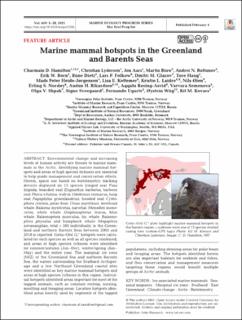Marine mammal hotspots in the Greenland and Barents Seas
| dc.contributor.author | Hamilton, Charmain Danielle | |
| dc.contributor.author | Lydersen, Christian | |
| dc.contributor.author | Aars, Jon | |
| dc.contributor.author | Biuw, Martin | |
| dc.contributor.author | Boltunov, Andrei | |
| dc.contributor.author | Born, Erik W. | |
| dc.contributor.author | Dietz, Rune | |
| dc.contributor.author | Folkow, Lars | |
| dc.contributor.author | Glazov, Dmitry M. | |
| dc.contributor.author | Haug, Tore | |
| dc.contributor.author | Heide-Jørgensen, Mads-Peter | |
| dc.contributor.author | Kettemer, Lisa Elena | |
| dc.contributor.author | Laidre, Kristin L. | |
| dc.contributor.author | Øien, Nils Inge | |
| dc.contributor.author | Nordøy, Erling Sverre | |
| dc.contributor.author | Rikardsen, Audun H. | |
| dc.contributor.author | Rosing-Asvid, Aqqalu | |
| dc.contributor.author | Semenova, Varvara | |
| dc.contributor.author | Shpak, Olga V. | |
| dc.contributor.author | Sveegaard, Signe | |
| dc.contributor.author | Ugarte, Fernando | |
| dc.contributor.author | Wiig, Øystein | |
| dc.contributor.author | Kovacs, Kit M. | |
| dc.date.accessioned | 2022-01-18T08:59:31Z | |
| dc.date.available | 2022-01-18T08:59:31Z | |
| dc.date.created | 2022-01-03T08:26:35Z | |
| dc.date.issued | 2021 | |
| dc.identifier.citation | Marine Ecology Progress Series. 2021, 659 3-28. | |
| dc.identifier.issn | 0171-8630 | |
| dc.identifier.uri | https://hdl.handle.net/11250/2837811 | |
| dc.description.abstract | Environmental change and increasing levels of human activity are threats to marine mammals in the Arctic. Identifying marine mammal hotspots and areas of high species richness are essential to help guide management and conservation efforts. Herein, space use based on biotelemetric tracking devices deployed on 13 species (ringed seal Pusa hispida, bearded seal Erignathus barbatus, harbour seal Phoca vitulina, walrus Odobenus rosmarus, harp seal Pagophilus groenlandicus, hooded seal Cystophora cristata, polar bear Ursus maritimus, bowhead whale Balaena mysticetus, narwhal Monodon monoceros, white whale Delphinapterus leucas, blue whale Balaenoptera musculus, fin whale Balaenoptera physalus and humpback whale Megaptera novaeangliae; total = 585 individuals) in the Greenland and northern Barents Seas between 2005 and 2018 is reported. Getis-Ord Gi* hotspots were calculated for each species as well as all species combined, and areas of high species richness were identified for summer/autumn (Jun-Dec), winter/spring (Jan-May) and the entire year. The marginal ice zone (MIZ) of the Greenland Sea and northern Barents Sea, the waters surrounding the Svalbard Archipelago and a few Northeast Greenland coastal sites were identified as key marine mammal hotspots and areas of high species richness in this region. Individual hotspots identified areas important for most of the tagged animals, such as common resting, nursing, moulting and foraging areas. Location hotspots identified areas heavily used by segments of the tagged populations, including denning areas for polar bears and foraging areas. The hotspots identified herein are also important habitats for seabirds and fishes, and thus conservation and management measures targeting these regions would benefit multiple groups of Arctic animals. | |
| dc.language.iso | eng | |
| dc.subject | Klimaendringer | |
| dc.subject | Climate change | |
| dc.subject | Sjøpattedyr | |
| dc.subject | Marine mammals | |
| dc.subject | Arktis | |
| dc.subject | Arctic | |
| dc.title | Marine mammal hotspots in the Greenland and Barents Seas | |
| dc.type | Peer reviewed | |
| dc.type | Journal article | |
| dc.description.version | publishedVersion | |
| dc.subject.nsi | VDP::Marinbiologi: 497 | |
| dc.subject.nsi | VDP::Marine biology: 497 | |
| dc.source.pagenumber | 3-28 | |
| dc.source.volume | 659 | |
| dc.source.journal | Marine Ecology Progress Series | |
| dc.identifier.doi | 10.3354/meps13584 | |
| dc.identifier.cristin | 1973455 | |
| dc.relation.project | Regionale forskningsfond Nord-Norge: 282469 | |
| cristin.ispublished | true | |
| cristin.fulltext | original | |
| cristin.qualitycode | 2 |
Tilhørende fil(er)
Denne innførselen finnes i følgende samling(er)
-
Articles [3001]
-
Publikasjoner fra CRIStin [3025]
